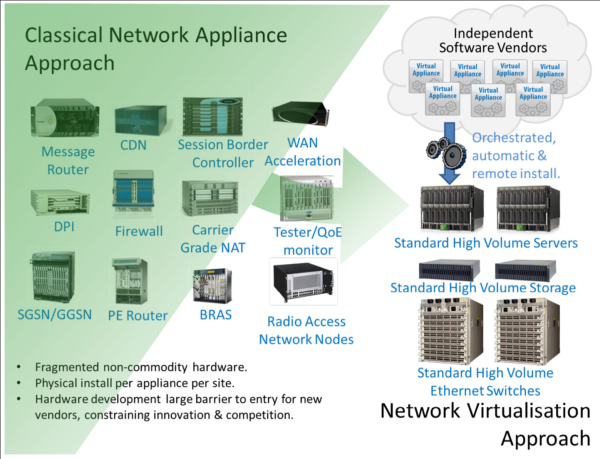Login to access
Want to subscribe?
This article is part of: Executive Briefing Service, Network Innovation Network Innovation
To find out more about how to join or access this report please contact us
This extract from our recent Executive Briefing on Software Defined Networking (SDN), describes ‘Network Functions Virtualisation’ (NFV), the problems it solves, and how it relates to SDN. (June 2013, Foundation 2.0, Executive Briefing Service, Cloud & Enterprise ICT Stream.) Network Functions Virtualisation (NFV) Approach June 2013
Network Functions Virtualisation
What is Network Functions Virtualisation?
Network Functions Virtualisation (NFV) is an ominous sounding term, but on examination relatively easy to understand what it is and why it is needed.
If you run a network whether as an enterprise customer or as a service provider you will end up a stack of dedicated hardware appliances performing a variety of functions needed to make the network work or to optimise its performance. Boxes like Routers, Application Load Balancers, Session Border Controllers (SBC), Network Address Translation (NAT), Deep Packet Inspection (DPI) and Firewalls to pick just a few. Each one of these hardware appliances needs space, power, cooling, configuration, backup, capital investment, replacement as they become obsolete and people who can deploy and manage them leading to on-going capex and opex. And with a few exceptions, each performs a single purpose, so a firewall is always a firewall or an SBC is always an SBC and neither can perform the function of the other.
Contrast this model with the virtualised server or cloud computing world where Virtual Machines run on standard PC/Server hardware, where you can add more compute power/storage on an elastic basis should you need it and where network cards are only required when you connect one physical device to another.
What problems does NFV solve?
NFV seeks to solve the problems of dedicated hardware by deploying the network functions on a virtualised PC/server environment. NFV started as a special interest group running under the auspices of the European Telecommunications Standards Institute (ETSI) by 7 of the world’s largest telecoms operators and has now been joined by additional telecoms companies, equipment vendors and a variety of technology providers.
While NFV can replace many dedicated hardware devices with a virtualised software platform, it is yet to be seen if this approach can deliver the sustained performance and low latency that is currently delivered by some specialised hardware appliances such as load balancing, real time encryption or deep packet inspection.
Figure 8 shows ETSI’s vision of NFV.
Figure 8 – ETSI’s vision for Network Functions Virtualisation

Source ETSI
Report Contents
- Network Functions Virtualisation
- What is Network Functions Virtualisation?
- What problems does NFV solve?
- How does NFV relate to Software Defined Networking (SDN)?
- Relative benefits of NFV and SDN
- STL Partners and the Telco 2.0™ Initiative
Report Figures
- Figure 8 – ETSI’s vision for Network Functions Virtualisation
- Figure 9 – Network Functions Virtualised and managed by SDN
- Figure 10 – Network Functions Virtualisation relationship with SDN
